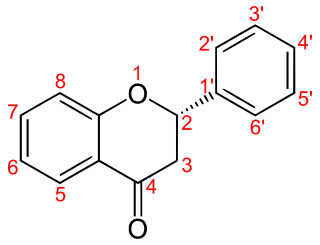
Flavonoids are a class of polyphenolic secondary metabolites found in plants, and thus commonly consumed in the diets of humans.

Flavan-3-ols are a subgroup of flavonoids. They are derivatives of flavans that possess a 2-phenyl-3,4-dihydro-2H-chromen-3-ol skeleton. Flavan-3-ols are structurally diverse and include a range of compounds, such as catechin, epicatechin gallate, epigallocatechin, epigallocatechin gallate, proanthocyanidins, theaflavins, thearubigins. They play a part in plant defense and are present in the majority of plants.

The flavanones, a type of flavonoids, are various aromatic, colorless ketones derived from flavone that often occur in plants as glycosides.

Gallocatechol or gallocatechin (GC) is a flavan-3-ol, a type of chemical compound including catechin, with the gallate residue being in an isomeric trans position.
In enzymology, a dihydrokaempferol 4-reductase (EC 1.1.1.219) is an enzyme that catalyzes the chemical reaction
In enzymology, a flavanone 4-reductase (EC 1.1.1.234) is an enzyme that catalyzes the chemical reaction
In enzymology, an anthocyanidin reductase (EC 1.3.1.77) is an enzyme that catalyzes the chemical reaction

The 3-Deoxyanthocyanidins and their glycosides are molecules with an anthocyanidins backbone lacking an hydroxyl group at position 3 on the C-ring. This nomenclature is the inverse of that which is commonly used in flavonoids, where the hydroxy-group is assumed absent if it is not specified, e. g. flavan-3-ol, flavan-4-ol, flavan-3,4-ol and flavonol.
The molecular formula C15H14O5 (molar mass : 274.26 g/mol, exact mass : 274.084123) may refer to:

The flavans are benzopyran derivatives that use the 2-phenyl-3,4-dihydro-2H-chromene skeleton. They may be found in plants. These compounds include the flavan-3-ols, flavan-4-ols and flavan-3,4-diols (leucoanthocyanidin).

The flavan-4-ols (3-deoxyflavonoids) are flavone-derived alcohols and a family of flavonoids. Flavan-4-ols are colorless precursor compounds that polymerize to form red phlobaphene pigments. They can be found in the sorghum. Glycosides can be isolated from a methanol extract of the rhizomes of Abacopteris penangiana.

Luteoforol is a chemical compound belonging to the flavan-4-ol class of flavonoids.
The molecular formula C15H14O4 may refer to:

Epicatechin gallate (ECG) is a flavan-3-ol, a type of flavonoid, present in green tea. It is also reported in buckwheat and in grape.

Robinetinidin is an anthocyanidin, a type of flavonoid.

Cassia abbreviata, commonly known as the sjambok pod or long-tail cassia, is a mostly tropical tree species in the genus Cassia, which is native to Africa.

Condensed tannins are polymers formed by the condensation of flavans. They do not contain sugar residues.
Menisciopsis penangiana is a fern species in the genus Menisciopsis. It has many synonyms, including Abacopteris penangiana and Pronephrium penangianum.

Gambier or gambir is an extract derived from the leaves of Uncaria gambir, a climbing shrub native to tropical Southeast Asia. Gambier is produced in Indonesia and Malaysia where it was an important trade item into the late nineteenth century. It can be used as a tanning agent, a brown dye, a food additive and as herbal medicine. Also known as pale catechu, white catechu or Japan Earth, it is often confused with other forms of catechu.

Oritin is a flavan-3-ol, a type of flavonoid. It is a component of the proteracacinidin tannins of Acacia galpinii and Acacia caffra.














